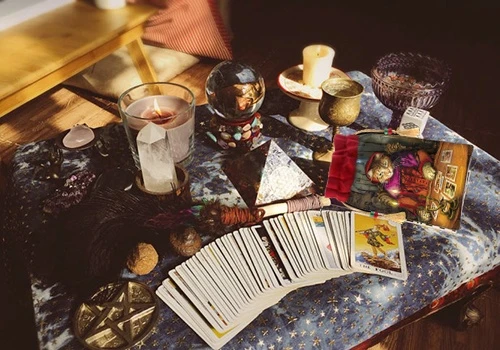
Like the iceberg's hidden mass beneath visible waters, consciousness forms but the smallest part of psyche's totality. The great pioneer Freud recognized that beneath awareness lies the vast realm of the unconscious, where untapped spiritual gifts and mystical powers await awakening. In daily life, focused on the material realm like the King of Pentacles counting his coins, we lose touch with these deeper waters. Yet within that sacred depth dwells our innate capacity for prophecy and insight.
When we consciously engage with Tarot's sacred symbols, like the Magician channeling divine power through his tools, we open gates between worlds. Information flows from unconscious depths, revealing the eternal patterns connecting past, present and future. Here begins true divination - not mere fortune-telling, but communion with soul's timeless wisdom.
Those versed in psychology's mysteries often recognize in Tarot the same archetypal patterns Jung discovered in humanity's collective unconscious. Like the World card encompassing all elements in sacred dance, these universal symbols speak to the shared spiritual heritage dwelling in every human heart.
The great Tarot masters - Renner, Rachel, Abati - approached these mysteries with the same reverence as depth psychologists exploring the soul's labyrinth. Their work reveals Tarot as far more than divination - a sacred tool for healing and transformation, especially powerful in work with children whose souls remain close to archetypal realms.
Those seeking Tarot's wisdom often carry fear's shadow, like the Moon card's creatures dwelling in unconscious depths. Simply predicting the future cannot dispel these deeper anxieties. True transformation requires facing our shadows with the Strength card's courage and compassion.
Life itself moves like the Wheel of Fortune, containing both light and shadow. As Renner wisely noted, fairy tales that show only life's bright face do us a disservice. True wisdom, like the High Priestess's teachings, embraces both darkness and light as essential aspects of the whole.
Some readers prefer to maintain Tarot's purely mystical aspect, yet I advocate for grounding these mysteries in psychological understanding. Like the Hierophant bridging heaven and earth, we need not choose between magic and meaning. The deeper mystery lies in their sacred union.
Too often, those who would keep Tarot purely magical are actually avoiding their own fears, like the Moon card's crayfish refusing to emerge from unconscious waters. This brings to mind Osho's "Schizophrenia" card - the pain of remaining divided between mystical ideals and earthly reality.
While Tarot and psychology walk different paths, like the Two of Wands' choice of directions, both lead inward to wisdom's source. Whether we choose cards or therapeutic techniques, the essential work remains: helping others see their path clearly and find courage to walk it, like the Fool stepping faithfully into the unknown.